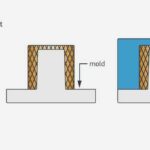
Are you a car enthusiast who appreciates the timeless beauty of classic automobiles? If so, then you’ve probably heard of the iconic Jaguar E-Type and D-Type models. These two legendary cars have left an indelible mark on the automotive industry, but what sets them apart? In this article, we will delve into the key differences between the Jaguar E-Type and D-Type, exploring their design, performance, and historical significance. From the sleek and elegant lines of the E-Type, to the D-Type’s dominating presence on the racetrack, each model has its own unique characteristics that make it truly special. Whether you’re a hardcore Jaguar fan or simply curious about these legendary machines, join us as we take a closer look at the fascinating world of the Jaguar 1960s etype and D-Type. Get ready to be captivated by their graceful curves, raw power, and the stories that have made them automotive icons.
History and origins of the Jaguar E-Type
The Jaguar E-Type, also known as the Jaguar XK-E, was introduced in 1961 and quickly became an instant sensation. Its origins can be traced back to the Jaguar D-Type, which had achieved great success in endurance racing in the 1950s. The E-Type was designed as a road-going version of the D-Type, incorporating many of its advanced engineering features. It was unveiled at the Geneva Motor Show, where it captured the hearts of car enthusiasts with its striking design and impressive performance.
The E-Type was the brainchild of Sir William Lyons, the founder of Jaguar Cars, and Malcolm Sayer, the renowned aerodynamicist. Their collaboration resulted in a car that was not only aesthetically pleasing but also incredibly fast. The E-Type was powered by a 3.8-liter inline-six engine, delivering an impressive 265 horsepower. This allowed the car to accelerate from 0 to 60 mph in just 6.9 seconds, making it one of the fastest production cars of its time.
The E-Type’s design was revolutionary, featuring sleek lines, a long bonnet, and a distinctive curved rear. It was a true masterpiece of automotive design, capturing the essence of speed and elegance. The car’s interior was equally impressive, with luxurious leather seats, a wood-rimmed steering wheel, and an array of gauges and switches that emphasized its sporting pedigree. The E-Type quickly became a symbol of style and sophistication, attracting the attention of celebrities and enthusiasts alike.
History and origins of the Jaguar D-Type
The Jaguar D-Type, which preceded the E-Type, was born out of a desire to dominate the world of motorsport. In the 1950s, Jaguar had achieved considerable success in racing, but Sir William Lyons wanted to take it to the next level. He set his sights on winning the prestigious 24 Hours of Le Mans, the most grueling endurance race in the world. To accomplish this, Jaguar needed a car that was not only fast but also aerodynamically efficient.
The D-Type was the result of extensive research and development. It featured a monocoque construction, which was a first for a racing car at the time. This lightweight and rigid structure allowed for improved handling and stability at high speeds. The D-Type also introduced the use of disc brakes, another groundbreaking innovation that revolutionized the world of motorsport. These advancements, coupled with a powerful 3.4-liter inline-six engine, gave the D-Type a competitive edge on the racetrack.
In 1955, the D-Type made its debut at the 24 Hours of Le Mans, and it immediately showed its potential. It went on to win the race in 1955, 1956, and 1957, solidifying Jaguar’s reputation as a force to be reckoned with in motorsport. The D-Type’s success on the track was a testament to its exceptional engineering and design. It was a true racing machine, built to conquer the most demanding circuits in the world.
Design and aesthetics of the Jaguar E-Type
When it comes to design, few cars can rival the Jaguar E-Type. From its long, sweeping bonnet to its perfectly proportioned rear, every curve and contour of the E-Type exudes elegance and sophistication. The car’s design was heavily influenced by aerodynamics, with a low drag coefficient that enhanced its performance. The E-Type’s iconic oval grille, covered headlights, and sleek profile gave it a distinctive and timeless look that still turns heads today.
Inside the E-Type, the focus was on luxury and comfort. The car featured sumptuous leather seats, a stylish dashboard, and a wood-rimmed steering wheel that added to its classic appeal. The E-Type was designed to be both a sports car and a grand tourer, offering a comfortable and refined driving experience. It was the perfect blend of beauty and performance, making it a true automotive icon.
Design and aesthetics of the Jaguar D-Type
While the Jaguar D-Type may not have the same level of refinement as the E-Type, its design is no less striking. The D-Type was purpose-built for racing, and every element of its design was focused on performance. Its aerodynamic shape, with a long nose and a tail fin, was designed to reduce drag and improve stability at high speeds. The D-Type’s body was made from aluminum alloy, further reducing weight and improving handling.
Inside the D-Type, the emphasis was on functionality rather than luxury. The car featured a simple cockpit with minimal creature comforts. The driver’s seat was positioned towards the center of the car, allowing for better weight distribution and improved handling. The D-Type was a true driver’s car, built for those who wanted nothing more than raw power and exhilarating performance.
Performance and engineering of the Jaguar E-Type
When it comes to performance, the Jaguar E-Type is nothing short of exceptional. Its 3.8-liter inline-six engine, coupled with its lightweight construction, allowed the car to achieve impressive speeds. The E-Type could reach a top speed of 150 mph, making it one of the fastest production cars of its time. Its acceleration was equally impressive, with a 0 to 60 mph time of just 6.9 seconds.
The E-Type’s engineering was ahead of its time. It featured independent suspension, disc brakes, and rack-and-pinion steering, all of which contributed to its superb handling and responsiveness. The car’s lightweight construction, with its aluminum bonnet, doors, and boot lid, further enhanced its performance. The E-Type was a true driver’s car, offering a thrilling and exhilarating experience on the road.
Performance and engineering of the Jaguar D-Type
When it comes to performance, the Jaguar D-Type is a true beast on the racetrack. Its 3.4-liter inline-six engine, with its advanced fuel injection system, delivered an impressive 250 horsepower. This, combined with the car’s lightweight construction and aerodynamic design, allowed it to achieve remarkable speeds. The D-Type could reach a top speed of 172 mph, making it one of the fastest cars of its time.
The D-Type’s engineering was groundbreaking. Its monocoque construction, with its aluminum alloy body, provided exceptional rigidity and strength. This, coupled with its advanced suspension and disc brakes, gave the D-Type unparalleled handling and stopping power. The car’s engineering excellence was further highlighted by its success on the racetrack, where it dominated the competition and secured its place in motorsport history.
Racing success and legacy of the Jaguar E-Type
While the Jaguar E-Type was primarily designed as a road car, it also had a successful racing career. The E-Type competed in various motorsport events, including the 24 Hours of Le Mans, where it achieved notable success. In 1961, a privately entered E-Type finished in fourth place overall, an impressive achievement for a production-based car. The E-Type’s racing success further solidified its reputation as a high-performance machine.
The E-Type’s legacy extends far beyond the racetrack. It is often hailed as one of the most beautiful cars ever made, with its timeless design still captivating car enthusiasts today. The E-Type’s influence can be seen in many modern sports cars, with its sleek lines and elegant proportions serving as inspiration for countless designers. The E-Type’s combination of style and performance has made it a true automotive icon that will continue to be admired for generations to come.
Racing success and legacy of the Jaguar D-Type
When it comes to racing success, few cars can match the Jaguar D-Type. The D-Type’s dominance on the racetrack is legendary, with three consecutive wins at the 24 Hours of Le Mans from 1955 to 1957. These victories cemented Jaguar’s place in motorsport history and showcased the D-Type’s exceptional performance and reliability. The D-Type’s success on the track was a testament to its advanced engineering and aerodynamic design.
The D-Type’s legacy extends far beyond its racing achievements. Its design and engineering innovations had a profound impact on the automotive industry. The use of monocoque construction and disc brakes, which were first introduced on the D-Type, became standard features in racing and road cars alike. The D-Type’s influence can be seen in many modern sports cars, with its aerodynamic shape and performance-focused design serving as inspiration for generations of car enthusiasts.
Collectability and value of the Jaguar E-Type and D-Type models
Both the Jaguar E-Type and D-Type are highly sought after by collectors and automotive enthusiasts. The E-Type’s timeless design and exceptional performance have made it a highly desirable classic car. Well-preserved examples of the E-Type can command high prices in the market, with certain rare models fetching millions of dollars at auctions. The E-Type’s collectability and value are a testament to its enduring appeal and status as a true automotive icon.
Similarly, the Jaguar D-Type is considered one of the most collectible and valuable classic cars in the world. Its racing pedigree, advanced engineering, and limited production numbers make it a rare and highly sought-after machine. Well-preserved D-Types are extremely rare and can command astronomical prices at auctions. The D-Type’s collectability and value are a testament to its historical significance and status as a true motorsport legend.
Conclusion and final thoughts
In conclusion, the Jaguar E-Type and D-Type are two iconic cars that have left an indelible mark on the automotive industry. While they share a common heritage, each model has its own unique characteristics that set it apart. The E-Type is a timeless beauty, with its sleek lines and exceptional performance capturing the hearts of car enthusiasts around the world. The D-Type, on the other hand, is a true racing machine, built to dominate the competition and showcase Jaguar’s engineering prowess.
Whether you’re drawn to the elegance of the E-Type or the raw power of the D-Type, there’s no denying the impact these cars have had on automotive design and performance. They are true automotive icons, representing the pinnacle of Jaguar’s engineering excellence and craftsmanship. Whether you’re a collector, a car enthusiast, or simply someone who appreciates the beauty of classic automobiles, the Jaguar E-Type and D-Type will continue to captivate and inspire for years to come.
So, sit back, relax, and let the fascinating world of the Jaguar E-Type and D-Type transport you to a time when cars were not just modes of transportation, but works of art. Experience the thrill of their graceful curves, the exhilaration of their raw power, and the stories that have made them legends in the automotive world.





